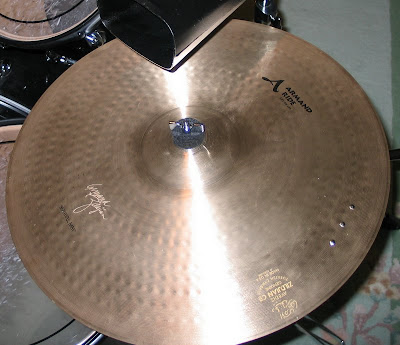Ride cym
A ride cymbal is a type of cymbal that is a standard part of most drum kits. Its function is to maintain a rhythm, rather than to provide accents. A right-handed drummer will normally place the main ride cymbal near his right hand.Terminology
According to most drummers, the term ride means to ride with the music as it sustains after it is struck. However, it can apply to either the function of the cymbal in the kit or to the characteristics of the cymbal itself. Most cymbal makers designate some of their cymbals as ride cymbals indicating they are designed primarily for this purpose.
Some drummers use a china cymbal, a sizzle cymbal or a specialised tone such as a swish or pang cymbal as a ride cymbal. When playing extremely softly, when using brushes, and when recording, even a paperthin crash may serve well a
s a ride cymbal.
On the other extreme, when playing extremely loudly a cymbal designed as a ride may serve well as a very loud, long crash. Some of Keith Moon's kits had only ride cymbals, with all but the largest of these serving as crashes.
The Crash/Ride Cymbal
Some cymbals are designated crash/ride or more rarely ride/crash to indicate that they are designed to serve either function, and perhaps which function is more likely. Such a cymbal will typically serve as both a large slow crash a nd a secondary ride, or it may be reserved for one purpose or the other in a particular playing situation.Sound of ride cymbals
When struck, a ride cymbal makes a sustained, shimmering sound rather than the longer, decaying sound of a crash cymbal. The most common diameter for a ride cymbal is about 20", but anything from 18" to 22" is standard. Larger and thinner cymbals tend towards a drier, shorter sound, while larger and thicker cymbals tend to respond better in louder volume situations, and conversely. Rides of up to 26" and down to 16" are readily available, and down to 8" are currently manufactured. The very thickest and loudest tend to be about 22", with larger rides restricted to medium and medium thin thicknesses.
In rock or jazz, the ride cymbal is most often struck regularly in a rhythmic pattern as part of the accompaniment to the song. Often the drummer will vary between the same pattern either on the hi-hat cymbal or the ride cymbal, playing for example the hi-hat in the verses and the ride in the instrumentals and/or choruses.
The sound of a ride cymbal also varies depending on what kind of mallet is used to hit it with. In rock and metal, wood and nylon-tipped drum sticks are common; wood creates a smoother, quieter sound, whereas nylon tips create more of a "ping," and a sharper bell tone. Brushes, used commonly in variations of jazz, make the ride cymbal more felt than heard, as it creates a low vibration to keep a steady beat, but a low sound volume.

No comments:
Post a Comment